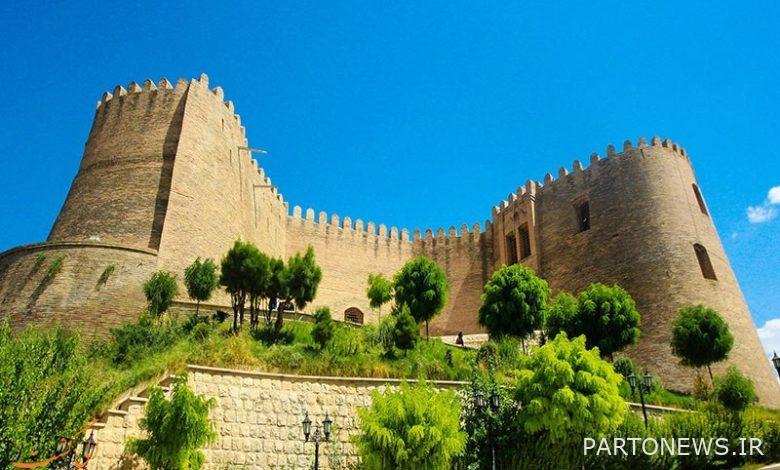Falak-ul-Aflak Castle, a view of the beautiful expanse of Iran/ a huge fortress above Khorramabad

According to the social reporter of Moj news agency, the city Khorramabad It is considered one of the green and beautiful cities in the western part, which has earned the title of the largest city of Larneshin in the country. This city has eye-catching beauty and always welcomes many tourists. In the center of this big city, there is a historical castle, which is known as Falak Alaflak. The eight-towered castle with an irregular base was built on an ancient hill with the same name and is currently located in the center of Khorramabad city.
Specifications of Shapoorkhasat fortress
Flak-el-Flak hill or Shapurkhashat fortress, with its complete aristocracy surrounding its area, is tightly surrounded by a military and educational bottleneck. Despite the connection of these heterogeneous facilities to this historical building in the south and east, and especially in the north, which is the only way for the public to travel on this side, its real privacy and historical location should be considered, of course, ignoring this additional building, from the east. And south of Khorramabad river, and from the west, Dozadhe Borji street and neighborhood, and from the north side, Falak al-Aflak narrow street.
The river flowing in the middle of Khorramabad city in the past, due to its abundant water, protected the building and its related areas from the three sides of the north-east, east and south from the danger of enemy attacks. The west covers a large part of the building and continues to the south.
The area of this castle on the ancient Falak El-Flak hill is about 5200 square meters and the surface of the nearby streets is about 40 meters. This castle has eight huge towers, two large courtyards and five relatively large halls and a number of separate rooms that are built in a special geometrical shape. The old water well is located a few steps above the floor of the courtyard, behind the archway in the northeast corner of the area, and it seems to have been connected to the source of Golestan on the northern slope of the hill. On the western wall of this area, beautiful patterns can be seen, as if these patterns were left over from the interior decorations of a bathroom that was destroyed years ago.
The ancient hill of Falak Al-Flak
Falak Alaflak Castle is located on an ancient hill, where crushed pottery is scattered in its corners. Documented scientific research has not been done about it yet, and no detailed excavation has been done. Ocher colored pottery with simple geometric motifs, which have been found in all ancient Iranian hills, belong to the 5th and 4th lunar millennia. This itself represents the life of the people who came from the cave to the plain and created the first villages – which later turned into cities. As many believe, Khorramabad corresponds to the city of “Khaidalu”.
During the Sassanid era, Khorramabad city and Falak al-Aflak fortress were called by the names of the city and the fortress “Shapur Khasat”. Due to its political and economic importance, this fortress has been a communication network that includes huge bridges such as Pul Dekhter and has been of special importance. Although the grandeur of this 5,300-meter building, with features such as a special water well and emergency escape routes, in the first place suggests that it is an ancient fortress, but in addition to them, the long clay rampart and its privacy should be taken into consideration. Contract; Of course, this represents the formation of early cities well and strengthens this mentality.
Registration of the castle as a historical monument
Falak El Aflak Castle was handed over to the Ministry of Culture and Art as a historical monument in 1348 and was registered as number 883 in the list of national monuments. In 1354, it was the location of Lorestan’s regional anthropology exhibition, and in 1356, it became a museum of Lorestan’s bronze works and Islamic era pottery.
This museum was closed after the Islamic revolution and the outbreak of the imposed war and due to the danger of air attack in 1363. Although the gradual restoration of the building continued during this period, but in 1366, the bombardment caused damage to the south-eastern part of the castle. In 1368, the photo exhibition hall and the castle stone and pottery museum were opened in this place, and now other halls are ready to be used for the anthropology exhibition and the Lorestan bronze museum. Finally, in this beautiful historical building, this castle was registered in the list of national monuments of Iran on Mehr 10, 1348.
How to go to the heavens?
To go to the stars, you just have to decide to travel to Khorram Abad. Falak Alaflak Castle has been used by many governments throughout history and has had various uses. In the past, this castle has been used as the seat of government, military barracks, prison, royal treasury and other military and political uses. Currently, this ancient fort has been changed and turned into an archeology museum, anthropology museum and a restoration laboratory of historical monuments so that those interested in visiting historical monuments can visit this building.

